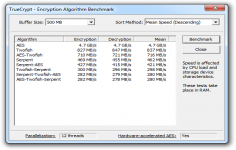 TrueCrypt 5.0
TrueCrypt 5.0
TrueCrypt Foundation - (Open Source)
Encrypting a USB key or a whole disk or even creating virtual encrypted disks, all these are possible with TrueCrypt.
TrueCrypt is a solution for storing encrypted information, allowing to create encrypted virtual disks. When mounted, the media appear in Explorer as a local disk. The application is also able to encrypt an entire volume or partition, which is very useful if there are sensitive information on the USB drive, for example. The encrypted volume is seen by the system as a typical hard and has all the features, being necessary only to enter the password associated with the volume at the time of "montage".
The software also includes hardware acceleration for encryption and decryption of AES algorithm. Enabled by default , this small revolution concerns only the recent Intel processors with the necessary capabilities : Intel Core i7- 980X , Intel Core i7 -970 , Intel Core i5- 650, Intel Core i5- 655K , Intel Core i5- 660, Intel Core i5 -661 , Intel Core i5 -670 , Intel Core i5 -680 and more, the speed of encoding and decoding being up to 8 times faster.
A volume can be mounted directly under Windows subject to provide the correct password. It is possible to create partitions and storage devices encrypted on the hard disk sectors with 4096, 2048 or 1024 bytes.
Many standard algorithms are supported by TrueCrypt, such as AES-256, Blowfish, CAST5, Serpent, Triple DES, and Twofish.
- Title:
- TrueCrypt 5.0
- File Size:
- 2.3 MB
- Requirements:
- Windows 2000 / XP / Vista / Windows7 / XP64 / Vista64 / Windows7 64 / Windows8 / Windows8 64
- Language:
- en-us
- License:
- Open Source
- Date Added:
- 05 Feb 2008
- Publisher:
- TrueCrypt Foundation
- Homepage:
- http://www.truecrypt.org
- MD5 Checksum:
- A3D94337991B4B84EAD758D868408823
New features:
Ability to encrypt a system partition/drive (i.e. a partition/drive where Windows is installed) with pre-boot authentication (anyone who wants to gain access and use the system, read and write files, etc., needs to enter the correct password each time before the system starts). For more information, see the chapter System Encryption in the documentation. (Windows Vista/XP/2003)
Pipelined operations increasing read/write speed by up to 100% (Windows)
Mac OS X version
Graphical user interface for the Linux version of TrueCrypt
XTS mode of operation, which was designed by Phillip Rogaway in 2003 and which was recently approved as the IEEE 1619 standard for cryptographic protection of data on block-oriented storage devices. XTS is faster and more secure than LRW mode (for more information on XTS mode, see the section Modes of Operation in the documentation).
Note: New volumes created by this version of TrueCrypt can be encrypted only in XTS mode. However, volumes created by previous versions of TrueCrypt can still be mounted using this version of TrueCrypt.
SHA-512 hash algorithm (replacing SHA-1, which is no longer available when Note: To re-encrypt the header of an existing volume with a header key derived using HMAC-SHA-512 (PRF), select 'Volumes' > 'Set Header Key Derivation Algorithm'.
Improvements, bug fixes, and security enhancements:
The Linux version of TrueCrypt has been redesigned so that it will no longer be affected by changes to the Linux kernel (kernel upgrades/updates).
Many other minor improvements, bug fixes, and security enhancements. (Windows and Linux)
Related software
2.2/5 from 179 users


